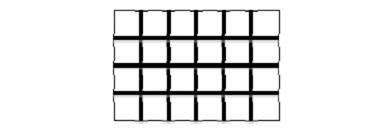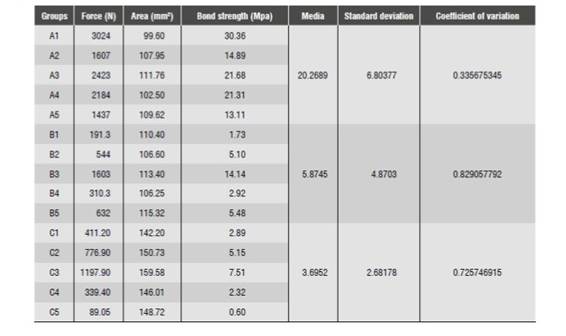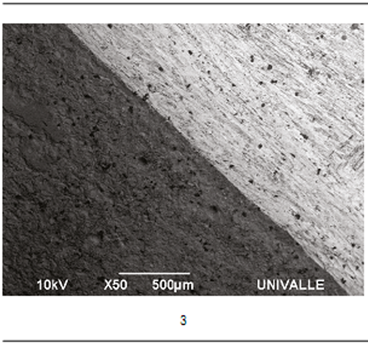INTRODUCTION
Zirconium is a chemical element discovered in 1789 by Martin Klaproth. It is one of the transition metals; it is lighter than steel and easily reacts with oxygen forming zirconium dioxide (ZrO2) or zirconia. In addition, it is abundant in nature. It cannot be found as a free metal, but as part of numerous minerals such as zirconium silicate (ZrSiO4) and baddeleyite, or yttrium-stabilized zirconium dioxide (Y-TZP). The use of this material in dentistry started in 1990 with applications in orthodontics, braces, intra-radicular posts, and implants and, since about a decade ago, as a component of fixed crowns and prostheses with great clinical success.1) This level of success results from its excellent physical-mechanical properties, high tenacity values, high hardness, resistance to wear, good frictional behavior, good electrical insulation, low thermal conductivity, and resistance to the corrosion of most acids and alkaline substances; in addition, its modulus of elasticity is similar to that of steel and its thermal expansion coefficient is similar to that of iron.2) Due to these conditions, it is unique among oxide ceramics as it has the highest values of all dental ceramics and therefore has elicited a considerable amount of interest in the dental community. It allows achieving partially fixed prostheses in the posterior sector with a substantial reduction in core thickness. These capabilities make it very attractive in dental prosthetics, where strength and aesthetics are fundamental; the introduction of computer-aided manufacturing techniques has increased its use.
Zirconium crystals undergo crystallographic changes ranging from the melting temperature (4919 °F) to room temperature; these changes are: monoclinic phase (room temperature-2138 °F), tetragonal phase (2138-4298 °F), and cubic phase (over 4298 °F). The transformation from tetragonal to monoclinic phase is accompanied by an increase in volume (4.5%), which is enough to cause a disastrous failure. This transformation is reversible and starts at 1742 °F, approximately during cooling. By mixing pure zirconium with metal oxides, such as calcium oxide (CaO), magnesium oxide (MgO), yttrium oxide (Y2O3), and cerium oxide (CeO3), one may achieve stability of the tetragonal phase at room temperature, thus controlling the stress produced during transformation from tetragonal to monoclinic phase, interrupting crack formation and achieving high levels of hardness. Procedures such as grinding, sandblasting, heat treatment, or ceramic coating trigger the transformation from tetragonal (t) to monoclinic (m) phase, accompanied by a substantial increase in volume (~4.5%), which is enough to affect long-term stability and the success of this material, influencing sensibility and aging. Inside cracks, zirconium crystals transform themselves from tetragonal to monoclinic, increasing the volume that prevents cracks from expanding. The remarkable mechanical properties of zirconium are mainly due to its transformation from tetragonal to monoclinic phase, which is induced by the cooling rate and/or by external traumatic situations (such as impacts, wear, or polishing).3)(4
One of the main complications of zirconium structures nowadays is ceramic coating delamination; it has been shown that this failure originates at the interface between structure and coating material. An amount of 13-15% complication rate after 2 to 5 years has been reported.5) The following factors have been identified as responsible for a decrease in bonding strength: tensions due to differences in the coefficients of thermal expansion (CTE) of zirconium and coating materials; low zirconium structure wettability; contraction of ceramic coating during the cooking process by thermal differences between it and the zirconium structure; a transformation phase of zirconium crystals in the interface due to thermal influences or loads; formation of failures during the manufacturing process; thickness of ceramic coating layer; the mechanical properties of each ceramic material; the structure′s elastic modulus; direction, magnitude, and frequency of applied loads; size and location of occlusal contact areas; residual stress induced at the time of manufacturing; defects at the cement-restoration interface, and environmental factors.6) Other causes of failure of the zirconium structure surface include type of ceramic coating and method of application. Some studies have compared the bonding strength of zirconium structure and ceramic coating, finding out that its values are lower than those of other allceramic systems, suggesting that zirconium structures with layers of ceramic coating are more susceptible to delamination during masticatory function.7
One of the critical aspects responsible for high failure rates is ceramic coating contraction during cooking due to thermal differences of ceramic and zirconium structure. During the cooking process, the ceramic is in its plastic state. The temperature interval that turns that ceramics from plastic to solid state occurs during cooling. This extrapolated temperature is defined as glass transition temperature. Stress in the ceramic coating is only possible below this temperature, i.e., in solid state. Therefore, another important aspect to take into account in stress formation besides the difference in thermal expansion coefficients is this change from glass transition temperature to room temperature.5
Several materials available in the market can be used to manufacture zirconium structures; despite sharing similar chemicals, these materials differ in manufacturing techniques, milling processes, and sintering temperatures, so it is recommended to perform different treatments on the structure surface.8
There are various techniques to reduce or avoid the delamination effect, including thermal control in terms of cooling or heating while the restoration is being performed,9) intrinsic characteristic factors of the material, or those recommended by the manufacturer, such as coefficient of thermal expansion,10) thermal conductivity,9) or mechanical properties.11) The appropriate selection of ceramic coating materials and zirconium structure plus proper surface treatment are extremely important to ensure that zirconium restorations are made according to the expected functional demands.8) Management of zirconium surfaces is one of the most researched treatments in the literature to evaluate shear bond strength between zirconium and coating ceramic; the goal of this study is therefore to compare shear bond strength at the zirconium-ceramic coating interface by making changes in the zirconium surface by means of mechanical gridding using two different methods, and making comparisons with a zirconium surface with no modification.
MATERIALS AND METHODS
Preparation of samples
Eight pre-sintered yttrium-stabilized zirconium dioxide (Y-TZP) blocks by Ceramill Zi Blanks (Amann Girrbach GmbH Austria Koblach) measuring 40 x 20 x 16 mm were cut in halves with a diamond disc, resulting in 16 blocks of 20 x 20 x 16 mm; the cut surfaces were polished with sandpaper #400. 15 blocks were randomly picked and one was discarded. The 15 blocks were randomly sorted out into 3 groups with 5 samples each (ISO Standard 9693, 6872, and 11405): Group A was the control group, with no bonding surface treatment; Group B was subjected to modification at the surface bonding to the ceramic coating using a diagonal round HP-1 carbide bur, reference 14823 (SS White. Lakewood NJ, USA), grinding diagonally towards the far ends of each sample, as shown in Figure 1, and Group C also underwent modification at the surface bonding to the ceramic coating using a quadrangular round HP-1 carbide bur, reference 14823 (SS White. Lakewood NJ, USA), as shown in Figure 2. The samples were sintered in an oven (Ceramill Therm, series 20-901011. Amann Girrbach GmbH Koblach, Austria) following the manufacturer′s recommendations, obtaining blocks with a final length of 18 x 18 x 14 mm after sintering.
Once the samples were sintered, they were rinsed with 70% alcohol under NEY ultrasound for 3 minutes. A brush was used to apply a thin smooth layer of liner (IPS e.max Zirliner, Ivoclar Vivadent, Schaan, Liechtenstein) on the bonding surface of zirconium blocks, which were cooked at 3200 °F in an oven (Programat EP 300, series 200703. Ivoclar Vivadent, Schaan, Liechtenstein), according to the manufacturer′s recommendations. Using the stratified technique, and mixing the powder/liquid of the D3 dentin shade nano-fluor-apatite ceramic coating (IPS e.max Ceram, Ivoclar Vivadent, Schaan, Liechtenstein) (Lot No. N51011), the ceramic was condensed layer to layer, making cubes with a silicone mold measuring 8 x 14 x 8 mm and removing excess moisture; each mold was removed and then cooked. Each layer of ceramic coating was taken to a furnace at 1382 °F (Programat EP 300, series 200703. Ivoclar Vivadent, Schaan, Liechtenstein) and cooked following the manufacturer′s recommendations.
Shear test
The samples were brought to a universal machine (Model 3366, Instron Corp., Norwood, MA, USA). They were fastened with clamps, positioning them in such a way that the cutting device was in contact with the interface of zirconium and ceramic coating. A load was applied on the axial axis of each block at a speed of 1 mm/min until fracture. The last load when the fracture occurred was recorded in Newton (N). Bond strength in MPa was calculated by dividing the load (N) at the time of fracture by bonding area, which was measured on each sample.
RESULTS
Table 1 summarizes the lab results, showing the behavior of samples in terms of the shear bond strength (SBS) of ceramic coating and zirconium in the three experimental groups: Group A was the control group, where zirconium surfaces were not subjected to any alteration or modification, Group B samples had their surface of bonding to ceramic coating modified by grinding diagonally with a round bur towards the ends of each sample, and Group C also had modifications on surface of bonding to ceramic coating by grinding with a square-shaped round bur. The average SBS values were 20.2 MPa ± 6.8 MPa for Group A, 5.87 MPa ± 4.87 Mpa for Group B and 3.69 ± 2.68 MPa for Group C. The table also shows force in Newton and bonding area in square millimeters for each sample; SBS is obtained by dividing force by area in each group, and is expressed in Mpa.
To evaluate data variability in each group, changes in coefficients of variation were analyzed, finding out that SBS variability in Group A was 33%, in Group B 82%, and in Group C 72%. This section shows the findings of this study through statistical analysis; it also shows the differences observed when comparing the behavior of the different zirconium surface treatments before shear testing.
Descriptive analysis
In accordance with the objectives of this study, all the obtained data were tabulated, analyzing SBS in the three groups by first using a normality test (Kolmogorov-Smirnov). Since this test yielded apvalue greater than 0.05, the population was considered to be normal and this allowed applying a parametric ANOVA tests. To compare SBS among the three groups, a one-way ANOVA test was used; the results of this test showed differences in strength averages among the three groups, being higher in Group A, which was not grinded, and such differences were statistically significant rejecting the hypothesis of normality (p> 0.05). The p value showed that the hypothesis of equality in bond shear strength among the groups is rejectable.
Comparative analysis
The ANOVA test allowed concluding that the three groups are not equal in terms of SBS; therefore, additional tests were conducted in order to determine significant differences among the three groups, using the Tukey′s range test to do this. The results are shown in Table 2. Group A had significant differences with Group B (p = 0.002) and Group C (p = 0.001), but Groups B and C did not show significant differences (p = 0.780). The post-hoc Tukey′s tests showed that the group that differs is Group A.
Multiple comparisons
Given the heterogeneity of variances among groups, the hypothesis of equality was validated by means of the non-parametric Tukey′ test; the results suggest that there is statistically significant difference for SBS (p ≤ 0.05).
Figure 3, Figure 4, Figure 5, Figure 6, Figure 7, Figure 8 show the zirconium-ceramic coating interface. These photographs were taken with a scanning electron microscope. Figure 3 and Figure 4 show Group A, with no surface treatment. Figure 5 and Figure 6 correspond to Group B, and Figure 7 and Figure 8 to Group C, with mechanical grinding. These last (Figure 5,Figure 6,Figure 7 and Figure 8) show bubbles and lack of ceramic coating homogeneity in the cavities performed with mechanical grinding.
Figure 4 Image of the zirconium-ceramic coating interface. Surfaces with no treatment. Group A. 200X
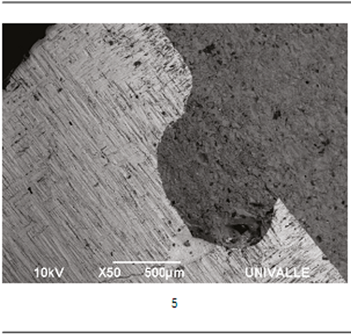
Figure 5 Image of the zirconium-ceramic coating interface. Surfaces with mechanical grinding. Group B. 50X
Figure 6. Image of the zirconium-ceramic coating interface. Surfaces with mechanical grinding. Group B. 200X.
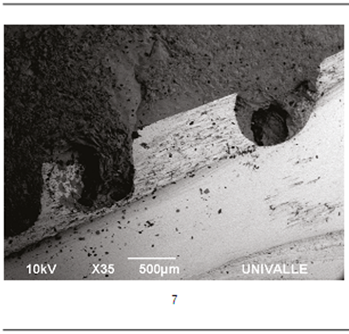
Figure 7 Image of the zirconium-ceramic coating interface. Surfaces with mechanical grinding. Group C. 35X
DISCUSSION
In recent years, research in dentistry has focused on new ceramic materials seeking to improve their mechanical properties, such as tenacity and bond strength to ceramic coating.12) The strength of materials is studied in very different ways. The studies generally analyze loads or compression flexural forces (axial or angular) on three or four points, as well as bending, sliding, shearing, traction, and torsion forces.13) The authors of the present study decided to analyze the shear test because it accurately reproduces many situations of the maxillarymandibular activity on dental restorations. This is why shear bond strength of zirconium and ceramic coating was measured according to ISO 9693.14
While some authors claim that the method for measuring bond strength is not consistent,12) currently shear testing is defined as a tests in which two parts are bonded and then applied a load until separation occurs. Shear bond strength is calculated by dividing the maximum applied force by bonding area. This test is relatively quick and easy to make and produces fast results. However, some critical aspects should be considered when using an in vitro test to predict the clinical behavior of a material. First, in vitro findings cannot be directly extrapolated to clinical situations, and, secondly, the shear bond strength test has abundant variations.15
Most studies on shear bond strength between dental materials, especially on ceramic materials, show important variations regarding sample location and manufacture, as well as size.13) In this study, and also in the study by Fischer et al in 2008,10) shear bond strength tests were performed on zirconium blocs of certain size according to the measurement instrument used (Instron 3366).
Clinically, most failures between zirconium and ceramics occur in the interface. This type of failure in the interface is one of the most commonly reported in the literature 16)(17)18)(19) and coincides with the type of adhesive failures found in this study. This interface is a vulnerable zone. According to Fischer et al,10) these failures can occur because of stress in the bonding area due to a significant difference in coefficient of thermal expansion between both materials. Studies suggest that the coefficient of thermal expansion of the ceramic coating should be slightly lower (0.5 x 10−6/K) than that of the structure, in order to reduce the slight residual compressive stress.3)(11
This study showed that using a bur to perform mechanical grinding on the zirconium surface significantly reduces shear bond strength to ceramic coating. Thus, these findings reject the null hypothesis, which suggests that performing retentions could improve bonding. This study also observed that lack of moisture on the zirconium surface can be one of the reasons for failure, agreeing with the study by Fischer et al in 2008.10) Similarly, lack of moisture greatly increases liner thickness in the retention areas-as shown in the scanning electron microscopy photos-.
Both CTE and conductivity of ceramic coating and zirconium structure have an influence on the interface. It is worth noting that temperature affects bonding of both materials, since temperature changes affects one of the materials more than the other, depending on the coefficients of thermal expansion and conductivity, which can cause tensions between them and produce shearing, resulting in delamination. According to Guess et al in 2008,9) controlling cooling temperature may reduce tensions within the interface, avoiding delamination. This condition is included in the manufacturer′s instructions; material management is important, but it is the manufacturer who should make these changes, so one way to reduce those effects is handling the zirconium surface and having an exact knowledge of the blocs that are to be used, so that they are of a high quality.20However, in previous studies, such as the one by Von Steyern et al in 2005,21) which analyzed microfractures and delamination of ceramic coating in zirconium structures, these facts are not only connected to weak bonding between zirconium and ceramic coating, but also to different structural ceramic coating characteristics in terms of composition, strength, CTE, and contraction by cooking.10) On the other hand, the diverse characteristics of zirconium oxide materials, in terms of particle size, shape, composition, density, and hardness,16 as well as temperature management while sintering and cooking the ceramic coating, may be related to these delamination processes.20
In order to improve bond strength between zirconium structure and coating material, some studies recommend sandblasting to achieve surface roughness in zirconium and create micro-retentions.7)(10) However, it has also been found that sandblasting can trigger a transition from tetragonal to monoclinic phase, affecting the mechanical strength of zirconium and most likely the binding capacity of the coating material.10)(11) This happens because the coefficient of thermal expansion of zirconium in monoclinic phase is 7.5 x 10−6/K, significantly lower than that of zirconium in tetragonal phase, 10.8 x 10−6/K. This creates a difference in coefficient of thermal expansion between zirconium and ceramic coating, producing tensions at the interface between these materials, which leads to fractures and ceramic delamination. It is very likely that the sandblasting effect, or a mechanical grinding like the one performed in this study, affect the mechanical strength of Y-TZP and the quality of bonding to ceramic coating.10
When comparing metal-ceramic and zirconiumceramic bonding, the latter was always lower, ranging from 21.9 to 31.0 MPa;22)(23)(24) in fact, the shear bond strength values found in this study ranged from 0.66 to 30.36 MPa, which are similar to the studies conducted by Aboushelib in 2006 and 2008.8)(16
Once the blocs are ready to be bonded to the ceramic coating, the liner is applied to the zirconium surface with a brush. The purpose of this material is masking the white shade of zirconium and providing wettability to its surface. The chemical composition of liners varies depending on manufacturer, but their main component is SiO2, which is the same as the ceramic coating.19
This study used mechanical grinding followed by liner application, as recommended by several manufacturers, and then ceramic application. The scanning electron microscope photos showed sectioned areas in the zirconium-ceramic coating interface, with abundant pore defects. This demonstrates that the liner did not produce excellent wettability or penetration on irregular surfaces, resulting in adhesive failure in all the samples that were modified with mechanical grinding. This may be compared to other studies, such as that by Fisher et al,10) who also assessed shear bond strength of ceramic coating making changes in the zirconium surface. The authors conclude that the strong bonding of the ceramic coating to the polished zirconium surface suggests a stable chemical bonding of both materials, while a rough surface produced by sandblasting does not improve bonding strength.
In other studies, such as those by Aboushelib et al in 2006, Kim et al in 2007, and Studart et al in 2007,16)(18)(19) liner application did not affect shear bond strength. They also observed adhesive interface failures, similar to the results of this study. The formation of porosity and microgaps on the interface is a factor that reduced bonding in the samples with mechanical retention, which is comparable with the findings by Guess in 2008, where such formation occurred as well.9)(16)(25)(26
In a study by Kim et al in 2011,18) the authors showed that liner application increases the chance of failure at the interface between ceramic coating and zirconium structure, and that sandblasting with aluminum oxide particles of 100 micrometers and a pressure of 0.4 MPa for 10 seconds can be more useful than applying a liner to increase bond strength. Their findings occurred in the control group, in which the surfaces were not treated, obtaining 32.08 MPa, while in samples with surface treatment with sandblasting the result was 36.63 MPa, with sandblasting and liner it was 30.51 MPa, and with liner only, 27.87 MPa. Contrary to the results of the present study, in groups B and C (where retentions were made), shear bond strength decreased compared with the control group (Group A), where surfaces were not prepared and only liner was applied, increasing bond strength in the interface. It is worth noting that this study used macro-grinding instead of micro-retentions as in the aforementioned study, which could have caused lack of wettability, allowing the liner to be deposited in these macro-retentions, resulting in low values.
Some studies conclude that sandblasting with Al2O3produces mechanical grinding on the zirconium surface, improving bond strength to ceramic coating.26)(27) Other studies, on the other hand, claim that sandblasting with Al2O3does not alter the zirconium surface in In-Ceram Zirconio, although this sandblasting was performed with aluminum oxide of 50 Μm in size at a pressure of 0.25 MPa.11
The findings of the present study, as well as those offered by other evidence, suggest the need for further studies on ways of obtaining optimal bonding between coating material and zirconium surface. Using smooth zirconium or macro- or microretentions with certain product, in addition to the use of liner, opens expectations for future bonding of this complicated interface. Achieving a stable bonding involves not only physical-mechanical concepts, but also adequate knowledge of materials and proper handling of them. Manufacturers should do their job, and technicians and clinicians should understand theirs, in order to achieve functional and long-lasting restorations.
CONCLUSIONS
With the limitations of this study and its results, the following conclusions can be drawn:
It is not necessary to prepare the zirconium surface with burs like the ones used in this study to improve bond strength to ceramic coating.
Lack of wettability plays an important role in preparing zirconium surfaces with macroretentions, since the liner′s surface tension may not be adequate on treated surfaces, decreasing bond strength between both materials.
Using zirconium with no prior surface preparation, or preparing it with macroretentions, opens the expectations on the interface between these two materials, because it is a complex interface due to the characteristics of involved materials. Achieving stable bonding involves not only physical-mechanical concepts, but also an adequate knowledge of these materials and appropriate handling of them by technicians and clinicians.
SUGGESTIONS
In light of the findings of the present study and those offered by other evidence, further research is needed in terms of the various ways of achieving optimal bonding between coating material and zirconium surface.
Manufacturers must be at the forefront to improve techniques and manufacturing methods of their products in general, in particular those referred to in this study, supported by serious research. They must also provide technicians and dentists with training in proper management; in turn, the latter should know these products in order to achieve functional and long-lasting restorations.











 text in
text in 


